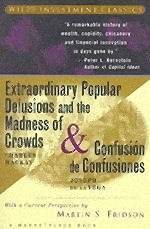 I am a little behind in my reviewing. I finished Extraordinary Popular Delusions and the Madness of Crowds by Charles Mackay & Confusion de Confusiones by Joseph De La Vega with a Current Perspective by Martin S. Fridson (long title) last week.
I am a little behind in my reviewing. I finished Extraordinary Popular Delusions and the Madness of Crowds by Charles Mackay & Confusion de Confusiones by Joseph De La Vega with a Current Perspective by Martin S. Fridson (long title) last week.
This is a collection of two books that are considered the two best books on investing ever written. The Mackay book, Extraordinary… was written in 1843 and the Vega book was written 1688. One would assume that the world has changed since then, but it seems that there is nothing new under the sun and that the stock exchange, as we know it today, was in place in the middle of the 1600s complete with bulls bears, brokers, mutual funds, and all of the same kinds of manipulations that still get us into trouble today.
The Mackay book is several chapters about investment bubbles from the original book that included other chapters about popular delusions. It includes the famous Tulip Bubble that was used to describe the internet irrational exuberance of the early part of this decade. The more interesting chapter deals with John Law, a Scottish gentleman gambler who somehow makes friends with the heir to the French throne. He is able to convince the government of France that they should issue paper money (this is around 1720) to finance their debt. France proceeds to print too much money and it causes, first a huge boom in speculation in stocks, and then a huge bust as the inflated economy busts. The behavior of the investors has not changed one bit since then and it does not matter if the date is 1720 or 2008, the economic principles are the same in both cases and the results were the same in both instances.
If you have ever heard someone tell you that “this time it is different” just go out and read this book and you will see that there is nothing new under the sun.
The second book, Confusion de Confusiones, is by a Portuguese Jew whose family fled from Portugal to Holland. Joseph de la Vega was a Sephardic Jew who spoke Dutch, whose parents spoke Portuguese, and wrote in Spanish in the style of Cervantes.
Confusion de Confusiones is a manual for stock traders written as a dialog between a shareholder, a merchant and a philosopher. The narrative works very well as a set of simple questions and answers and is only bogged down in detail when the author leaves the format. It describes in details the activities of the trading of shares of the East India and West India stock companies. Stocks are bought and sold on margin. There is short selling and trading in options, puts and calls. There is a kind of mutual fund that traded in both kinds of shares in order to spread out the risk. There was trading in fractional shares that were not backed by actual shares, which were packaged risk without the security. There are scoundrels and thieves. There are honest brokers and there are those that purposely try to cheat.
Vega describes the bulls and the bears quite well, even calling them bulls and bears. Anyone who has ever bought and sold stock will see that there the process has not really changed in 350 years.
The books are instructive and should be required reading for anyone who owns stock.